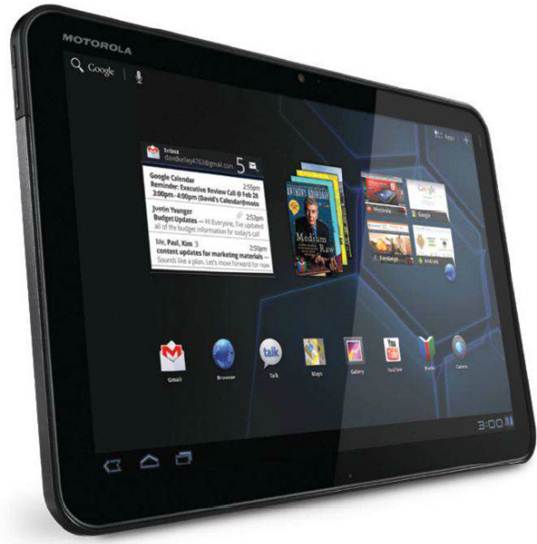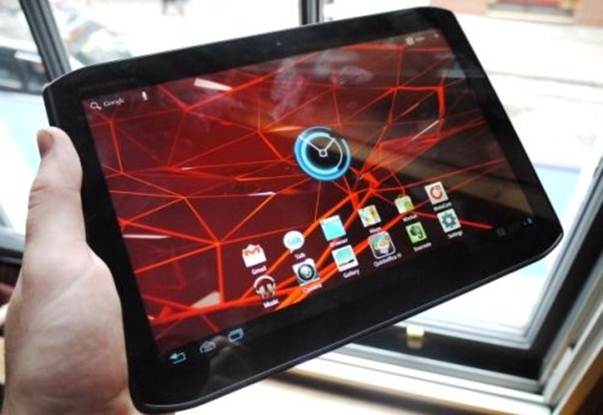The original Motorola Xoom caused quite a
stir, as it was the first tablet to come with Honeycomb, or Android 3.0,
Google's first attempt at an operating system that is designed for tablet-sized
displays.
It's a bit surprising that the 10.1-inch
Motorola Xoom 2 doesn't come with Ice Cream Sandwich, the latest version of
Android. That isn't a huge issue, since it will arrive in the future, and
Honeycomb still runs well and looks great on the Xoom 2's 16:10 format IPS
1.280x800 screen.

Motorola
Xoom 2
The Xoom 2 weighs 600g, about the same as
the iPad 2, but the wide-format display means it feels very different to hold.
Our opinion of widescreen tablets is mixed. On one hand, they're great for
films, but the classic 4:3 format of the Samsung Galaxy Tab 10.1 is usually
preferable for general tablet use.
Android 3.2 runs smoothly on the Xoom 2.
Thanks to its 1.2 GHz dual-core processor. Or at least, it does most of the
time. We did notice some occasional lag, usually when zooming in on web page.
The camera isn't bad. A 5MP rear camera is
enough for the odd shot, while a front camera for video char is 1.3MP. When in
video mode, the rear camera records HD video at 1080p.
What's more, battery life was superb,
managing 370 minutes of looped HD video, which is an excellent result.
Not so pen
A considerable advantage of Android is its
openness, because on most devices you can expand the storage with MicroSD
cards, and transfer files directly from your computer via USB, two things that
cannot be done on Apple's strictly controlled iPad.
However, Motorola has decided to follow
Apple's lead with the Xoom 2. A removable plastic clip reveals what appears to
be s MicroSD card slot, but it's just for decoration.

The
lack of expansion options will put many people off the Xoom 2
Connect a USB cable, and a read-only drive
appears with an installer for Motorola's Motocast software, an iTunes-like
gateway application that enables you to sync media from your computer onto the
device, as well as stream it directly from your computer over the web. One
shortcoming is you can't transfer media across directly in Windows, though.
While this application works fairly well in
practice, we think it’s a mistake for Motorola to abandon one of the most
useful aspects of the open Android approach. If you want more storage, you have
to purchase a device that comes with more built in, and the price difference is
more than the cost of a MicroSD card would be. Again, like the iPad, there are
3G versions of the Xoom 2 available, as well. And there is a mini HDMI slot, at
least.
The Samsung Galaxy Tab 10.1 performs
better, its battery life is just as good and its costs roughly the same. We
would still choose that over the Xoom 2. It simply feels less bulky and it
comes with fewer restrictions.
|
Details
|
|
Supplier
|
www..com
|
|
Specification
|
|
OS
|
Android
3.2
|
|
Processor
|
Nvidia
Tegra 2 1.2GHz
|
|
Ram
|
1GB
|
|
Storage
|
16GB
|
|
Expansion
|
None
|
|
Connectivity
|
802.11n,
GPS, HDTV OUT
|
|
Rear camera
|
5MP
|
|
Front camera
|
1.3MP
|
|
Screen type
|
IPS
|
|
Screen resolution
|
1280x800
|
|
Dimensions
|
Height: 173.6mm
Width: 253.9mm
Depth: 8.8mm
Screen size: 10.1-inch
Weight: 600g
|
|
|
|
The good
Excellent battery life, and widescreen
format
The bad
Quite bulky and restrictive in use